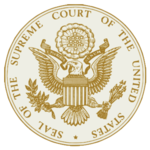Associate Justice
Associate justices of the Supreme Court of the United States are the members of the Supreme Court of the United States other than the chief justice of the United States. The authority of the Supreme Court is granted by Section I of Article III of the United States Constitution, which reads:
| “ | The judicial power of the United States, shall be vested in one Supreme Court, and in such inferior courts as the Congress may from time to time ordain and establish. The judges, both of the supreme and inferior courts, shall hold their offices during good behaviour, and shall, at stated times, receive for their services, a compensation, which shall not be diminished during their continuance in office.[1][2] | ” |
Nomination and confirmation
Justices to the Supreme Court are nominated by the president of the United States and confirmed by the United States Senate. Once justices are confirmed, they are appointed for life and are only removed from office by death, retirement or impeachment.
Oath of office
Each Supreme Court justice must take two oaths of office before joining the court; the constitutional oath of office required of all federal employees and the judicial oath, as found in the Judiciary Act of 1789.[3]
Number of justices
| Sound byte |
|---|
| Click this link for Franklin D. Roosevelt's Fireside Chat from March 9, 1937, where he explained the need for the Reorganization Bill. |
There are eight associate justices on the Supreme Court (plus the chief justice). This number of justices was set by the Judiciary Act of 1869.
One notable attempt to increase the number of associate justices came from President Franklin D. Roosevelt (D), who proposed the Judiciary Reorganization Bill of 1937. Roosevelt proposed appointing a new justice for every sitting justice over the age of 70. This would have amounted to six new justices at the time. Later, the Reorganization Bill was passed without the additional justice provision.[4]
Opinions
Unless a justice has recused from a case, he or she signs on to the opinion of the court. Because of the deliberation that occurs regarding opinions, no court opinion is official until it is released to the public (or more often, delivered in court).
Assigning opinions is one of the most important tools the chief justice has for building consensus. The chief justice has the authority to write any opinion, in the majority or dissent. From there, the chief justice may assign an opinion to an associate justice, and often wields this tool to attract a justice to an opinion.
When any justice drafts an opinion, he or she must take into account the points of view of their colleagues. If the authoring justice deviates from the consensus, the other justices may draft concurring or dissenting opinions.
The step of drafting opinions is confidential; the public is never aware of how a final opinion has changed from its original form. Experts of the court, however, look to the final opinions, votes, and how long it took to draft as signs to determine how an opinion changed from hearing to announcement.[5]
Salary
When the court was created in 1789, the chief justice was paid $4,000 a year and the associate justices received $3,500.[6]
Seniority
Associate justices have seniority by appointment; if two justices are appointed on the same day, seniority is based on age.[7]
Seniority determines the order in which justices sit during oral argument. It also has certain ramifications. For instance, the associate justice with the least seniority must answer the door to the conference room while justices are meeting and also takes notes. During conference, when justices verbally announce their votes before opinions are drafted, they speak in order of seniority.
Retired associate justices
If a justice retires from the Supreme Court, he or she may take senior status, thereby remaining a member of the court. Justices on senior status may serve on a specific case on a different federal court at the behest of the chief justice.[8][9]
See also
External links
Footnotes
- ↑ Cornell University Law School, Legal Information Institute, Article III
- ↑ Note: This text is quoted verbatim from the original source. Any inconsistencies are attributable to the original source.
- ↑ Supreme Court of the United States, "Text of the Oaths of Office for Supreme Court Justices"
- ↑ Senate Judiciary Committee, "United States Senate Committee on the Judiciary, Recess Reading: An Occasional Feature From The Judiciary Committee, "Franklin Delano Roosevelt's "Court Packing" Plan"," archived December 8, 2013
- ↑ United States Courts, "Supreme Court Procedures: Opinions"
- ↑ Federal Judicial Center, History of the Federal Judiciary, "Judicial Salaries of Supreme Court Justices"
- ↑ U.S. News, "10 Things You Didn't Know About the Supreme Court," October 2, 2009
- ↑ The Washington Post, "Retired Supreme Court justices still judge - and get judged," March 10, 2013
- ↑ The Washington Post, "A deep bench of substitute justices goes unused," August 9, 2010



